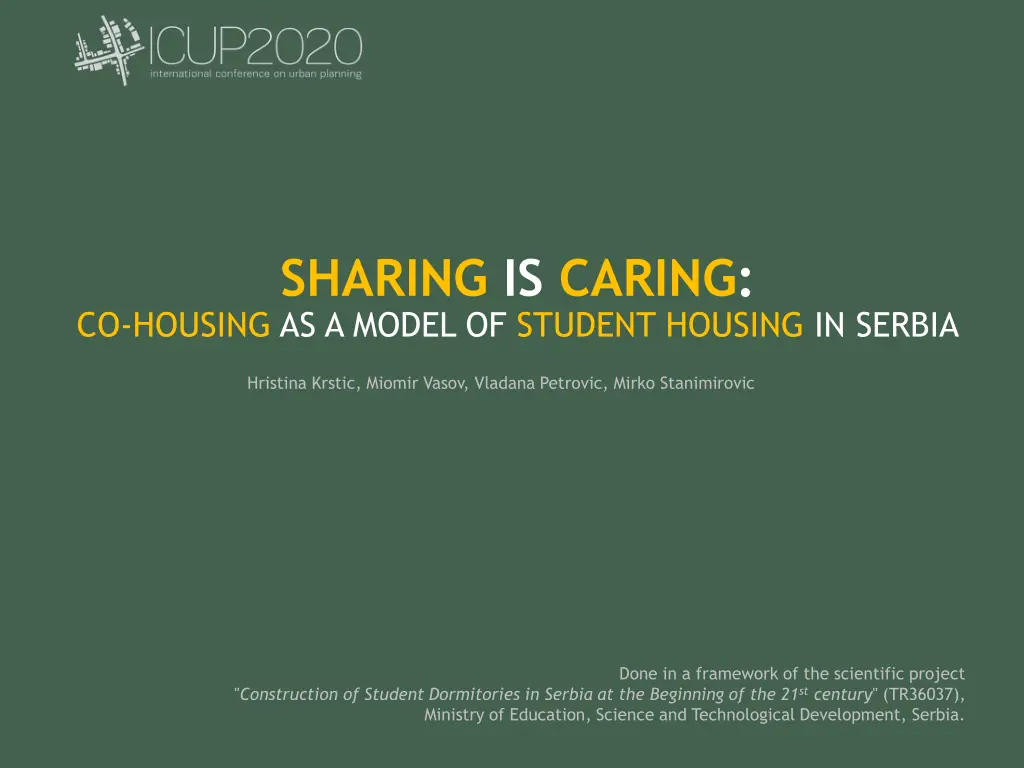
Co-Housing Initiatives in Europe - A New Model of Housing
Discover the concept of co-housing as a modern approach to community living, with examples from European countries like Sweden, Germany, and the UK. Learn how this innovative housing typology is seen as a model of the future, promoting collaborative living and alternative ways of housing.
Download Presentation

Please find below an Image/Link to download the presentation.
The content on the website is provided AS IS for your information and personal use only. It may not be sold, licensed, or shared on other websites without obtaining consent from the author. If you encounter any issues during the download, it is possible that the publisher has removed the file from their server.
You are allowed to download the files provided on this website for personal or commercial use, subject to the condition that they are used lawfully. All files are the property of their respective owners.
The content on the website is provided AS IS for your information and personal use only. It may not be sold, licensed, or shared on other websites without obtaining consent from the author.
E N D
Presentation Transcript
SHARING IS CARING: CO-HOUSING AS A MODEL OF STUDENT HOUSING IN SERBIA Hristina Krstic, Miomir Vasov, Vladana Petrovic, Mirko Stanimirovic Done in a framework of the scientific project "Construction of Student Dormitories in Serbia at the Beginning of the 21st century" (TR36037), Ministry of Education, Science and Technological Development, Serbia.
CO-HOUSING centraal wonen collaborative living collective housing mini-communities bof lleskab kollektivhus gemeinschaftliches wohnen abitare collaborativo
CO-HOUSING Is form of housing that combines characteristics of both individual and multifamily living. Its concept is based on the idea of community. Is quite new housing typology (1970s of the 20th century). Its expansion is globally taking hold.
CO-HOUSING INITIATIVES Unlike Serbia, where there are no registered co-housing groups, many European countries actively work on the development of this specific way of housing, seeing it as a model of housing of the future.
CO-HOUSING INITIATIVES Unlike Serbia, where there are no registered co housing groups, many European countries actively work on the development of this specific way of housing, seeing it as a model of housing of the future. In Sweden: more than 40 co-housing units as full members of the association that works on the promotion of collaborative housing and other alternative ways of living as well as 15 organisations working in favour of collaborative housing.
CO-HOUSING INITIATIVES Unlike Serbia, where there are no registered co housing groups, many European countries actively work on the development of this specific way of housing, seeing it as a model of housing of the future. In Germany: 27 regional offices within federal association FORUM.
CO-HOUSING INITIATIVES Unlike Serbia, where there are no registered co housing groups, many European countries actively work on the development of this specific way of housing, seeing it as a model of housing of the future. In UK: 21 established co-housing groups, 34 co-housing projects that are in the developing phase and 17 groups that are initially forming its membership.
CO-HOUSING INITIATIVES Unlike Serbia, where there are no registered co housing groups, many European countries actively work on the development of this specific way of housing, seeing it as a model of housing of the future. Similar associations in: Belgium, Czech Republic, Denmark, Netherlands, Poland, Austria, as well as out of Europe, like in the USA, Canada, Australia, New Zealand...
CASE STUDIES PORTO 15 (Diverserighestudio, Azienda Casa Emilia Romagna) LANGE ENG (Dorte Mandrup Arkitekter) MARMALADE LANE (Mole Architects) BASECAMP LYNGBY (Larz Gitz Architects, Kragh & Berglund)
PORTO 15 LANGE ENG MARMALADE LANE BASECAMP LYNGBY project name Albertslund (suburb of Copenhagen), Denmark Kongens Lyngby (suburb of Copenhagen), Denmark location Bologna, Italy Cambridge, UK completion date 2016 2009 2018 2020 building inside the block of the dense urban tissue type of property housing complex housing complex housing complex existing - renovation, conversion, reconstruction status new new new apartment ownership apartments to rent apartment owned by residents apartment owned by residents apartment to rent young people up to 35 (students, young professionals, married couples, single parents) students, professionals, seniors social structure multigenerational multigenerational continuous almost closed structure - peripheral row of housing units creates inner courtyard continuous closed structure - peripheral row of housing units creates inner courtyard semi closed structure - perforated rows of housing units create courtyards spatial form single compact structure openness to public open to public open to public open to public open to public
ADVANTAGES case study analysis stabile neighbourhood the interaction between different generations level of individuality/commonality can be set according to personal preferences more likely to create closer relationships with other people expressed solidarity and willingness to help (in childcare, chores, education) psychological effect
ADVANTAGES case study analysis possibility to finance the construction by joint forces of particular co-housing group (easier way to reach own home) possibility to be supported by other parties, who have non- profit interests and are willing to support sustainable living models lower living costs possibility to afford expensive amenities (swimming pool, gym) with less investment economical effect
ADVANTAGES case study analysis participation in design process and hence customization of living space according to personal preferences availability of wide range of contents, usually not accessible in conventional houses/buildings possibility to balance between privacy and publicity upon personal preferences and current needs and wishes comfort effect
ADVANTAGES case study analysis urban renewal social revivification urban effect
DISADVANTAGES case study analysis as a collaborative housing and particular alternative way of living is not suitable for every person: can require higher level of flexibility one should be able to accept the responsibility of sharing the life in commune can be "hustle and bustle"
BENEFITS FOR STUDENTS Living in a heterogeneous environment can help students to build a different network important for their professional and personal development. Living in co-housing creates family-like atmosphere and the sense of belonging to certain community. For students who have to move from their hometown during study period, co- housing can help with the integration process in new environment.
BENEFITS FOR STUDENTS Co-housing way of living is more adjusted to working people and modern lifestyle. Co-housing offers more comfortable, suitable and equipped accommodation in comparison to rented apartment. Although co-housing isn t exactly like a dormitory, it is somewhat similar, so students used to dormitory life will adapt to co-living fast. Frequent events offered inside co-housing can enhance social activity of students.
BENEFITS FOR STUDENTS Community-like living affects development of one's personality. Personal features like responsibility, tolerance, teamwork, humanity, environmental awareness and alike are more likely to be acquired in an environment like this.
CONCLUSIONS The rising number of co-housing projects intended for students demonstrates the fact that this typology is suitable for student living and is accepted by students. Co-housing can be graded as desirable, affordable and sustainable housing typology for a society. Higher sustainability is obvious in many aspects, primarily in ecological, economic and social.
CONCLUSIONS This housing typology is seriously becoming model of future housing. Although currently mostly spread across developed countries, it can be a good model for undeveloped countries too, especially when it comes to its economic aspect. Serbia can be a good candidate to introduce co- housing in its residential network.
CONCLUSIONS Co-housing can not only be a model for student housing in Serbia, but for housing in general - for housing of wider social groups. It can rise the quality level of housing, i.e. of people's lifestyle. Government should consider co-housing typology as sustainable housing model and support it. Co-housing is suitable for many social categories, who are in a way specific or vulnerable in relation to general society.

